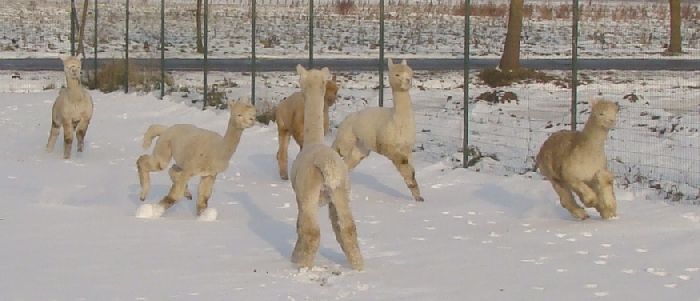Hulpvolle tips bij de geboorte
HELPFUL HINTS FOR BIRTHING
By Linda Blake, Southern Alpacas Stud
It is always with a mixture of relief and pride that we approach the end of a birthing season. All females pregnant, and all giving birth successfully - with a little bit of help from us humans.
And it is the "help" bit that I will focus upon, passing on some hints that helped us.
Some I learnt at the neo-natal course I went on in Australia, way back in 1996, and I’d encourage you to go on these courses when we hold them in New Zealand. Others I learnt through "trial and error" and the purpose of this article is to save you making the same errors.
Now, remember that Mother Nature does most of the work, and over 90% of births are normal - although 17% of first-time mothers do require some assistance.
Keep individual mating/birthing records for each female.
We record all matings and spit-offs, virtually all of which are done as pen matings, so we know when our females are due. They can of course come earlier, or later, than the due date !
We haven’t found any particular patterns for individuals - it appears to be more environmentally related - nutrition and weather.
We watch and wait patiently.
prepared and waiting for the birth
Keep your soon-to-be-mothers where you can see them.
starting to birthWe have a birthing paddock, and our females go into there 4 - 6 weeks prior to birth. Here we can watch them, and also increase their nutrition, providing higher protein feed, like lucerne chaff.
Watching a female circling around and alternatively sitting then standing, allowed our birthing helper time to change out of his bowling "whites" - otherwise they would have been "reds".
Pre-pack your birthing kit to grab in a hurry.
I now wash my hands thoroughly then run with my birthing kit, which includes a bottle of lubrication, gloves, old towel, iodine, portable phone, vet’s phone number, and pocket knife.
Nic, when working at the Hospital, once responded to my phone call for extra hands by breaking all the speed limits, with his excuse ready-made for the traffic officer - "I’m from the hospital and going to a difficult birth, officer !"
dam smelling to bond
Clear the breathing passages asap.
Ensure the mucus covering the face is cleared away from the nose and mouth so the cria can breathe air into its lungs. A number of ours have recently been born in a "caul", with a membrane bag covering the face. It is incredibly tough to break open, and that is what I use the pocket knife for. I was born in a caul myself, and for humans, it is supposed to be lucky.
15 minute rule.
A birthing alpaca should make progress every 15 minutes. She may rest, and she may even eat, as she pauses in the birthing process. What you want to see, is some progress every 15 minutes. This may be getting both legs, or more of the legs or neck coming out.
If there is no progress, assess what you can do, and alert your vet.
legs to one side
perfect positioningGet cria into correct position.
As long as you have two legs and a head, the birth should progress normally. You may need to sort the legs out so there is one either side of the head.
Position the head so it dangles down between the legs. This makes the shoulders narrower to birth.
(Try it yourself, with your arms and head.) The photo on the right shows perfect positioning for the birth to progress.
pelvis
Rotate the cria.
If the cria seems to be tightly wedged, remember that the pelvis is oval in shape, not circular. Slightly rotate the cria so its shoulders are in the widest part of the pelvis, which is on the diagonal. (About 10 to 4, using a clock face analogy.)
Legs but no head ?
which legsThe challenge when the head is missing, is whether you have front legs or back legs. If you have back legs, you can pull the cria out. But if they are front legs, you must have the head before you can commence to pull the cria out.
In our recent experience with a "missing head", my first step was to check which way the limbs bent. The first two joints of the front legs bend in the same direction, forming a U shape. By contrast, the first two joints of the back legs bend in opposite directions, forming a Z shape. (see diagram)
If it is front legs, as we had, you will then have to go inside to get the head to come forward and out. This is where you need your neo-natal course experience, practising on dead cria. Or your friendly vet. Know your limits.
Know when to call the vet.
Know your limits. Assess the situation, and call the vet once you are unsure or you are unable to progress the birth. For our "missing head" case above it took an epidural from the vet and much patience to extract the head of a cria which kept pulling its neck back and facing the rear, rather than fronting the cold, wet, (and increasingly bloodied) world outside.
applying iodine
After the birth
I apply iodine as soon as possible to guard against infection getting in via the cria’s navel. Very occasionally a cord needs clamping to stop excess bleeding.
Over the years we have become adept at guessing a cria’s weight, but weighing the cria within a few hours of birth will assist you in making decisions about its health and management.
clearing wax from teatsIt is useful to have two people at the after-birth stage - one to distract the possessive mother as you handle her precious cria!
Also, once the placenta is passed, the milk should begin to flow. You may need to gently ease out the waxy plugs in the nipples to get the milk started.
checking dam’s rear
At this stage take a look at the dam’s rear end too - look for splits and tears that may need cleaning to avoid infection.
Ensure the placenta is passed.
In the usual course of events, the placenta will be passed within a couple of hours. Ideally, stay around until the placenta is passed. One breeder had the misfortune to lose a cria which was suffocated by a placenta falling upon its head.
placenta checking
Spread the placenta out on the ground and check that it is all there. It should have two tips. Avoid handling the placenta with bare hands as it can potentially pass on diseases to humans - use gloves, or manipulate it with the spade. Take it away and bury it.
It is abnormal for the placenta not to be passed within 6 hours. After 12 hours, action is called for - usually the vet with an injection to encourage it to be passed. Retained placental membranes can cause infection in the dam very quickly, and it can be fatal.
proud mum and cria
welcome kissEnjoy !
Remember, most births are natural ! If you are lucky enough to catch that brief moment when a female gives birth herself, relax and enjoy it. It will be over so quickly, you’ll wonder why you were concerned at the event happening.
And watching mum greet her cria, and be so proud of it, makes the trials of birthing all worthwhile.
birthing kit
BIRTHING KIT
Bottle of water-based, sterile, lubrication
Gloves, both short and full arm length
Iodine - preferably at least 2.5% solution, liquid, or a spray bottle
Umbilical cord clamp - or clothes peg
Scales - bathroom ones, or hanging cria scales
Pocket knife
Portable phone and vet’s phone number
Bucket and spade for placenta collection
Old towels
Cria coat
Vet wrap to wrap the dam’s tail out of the way
[2009-02-23 door Linda Blake]







